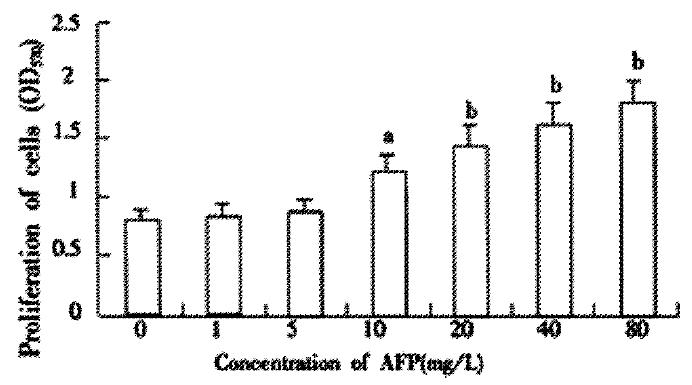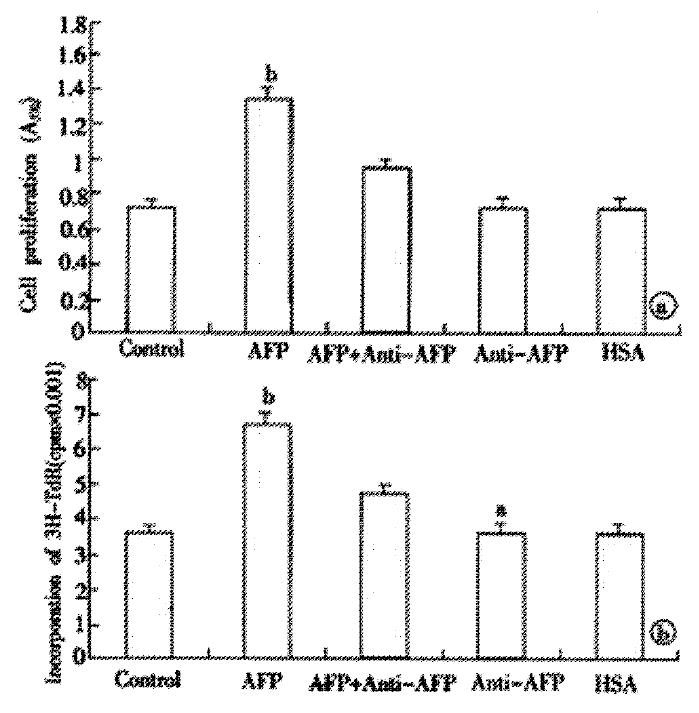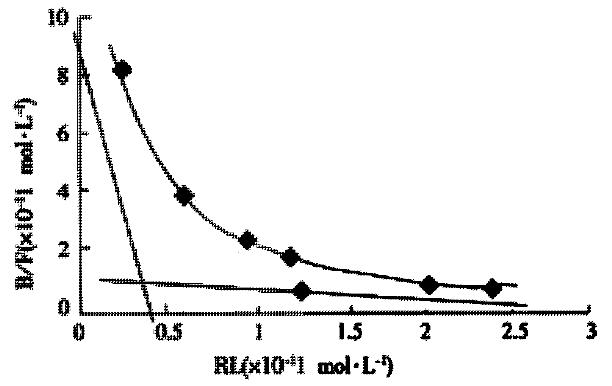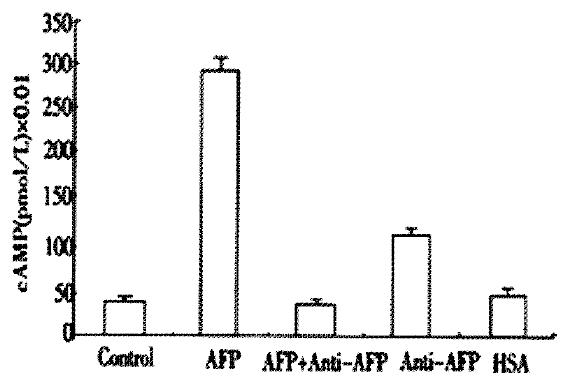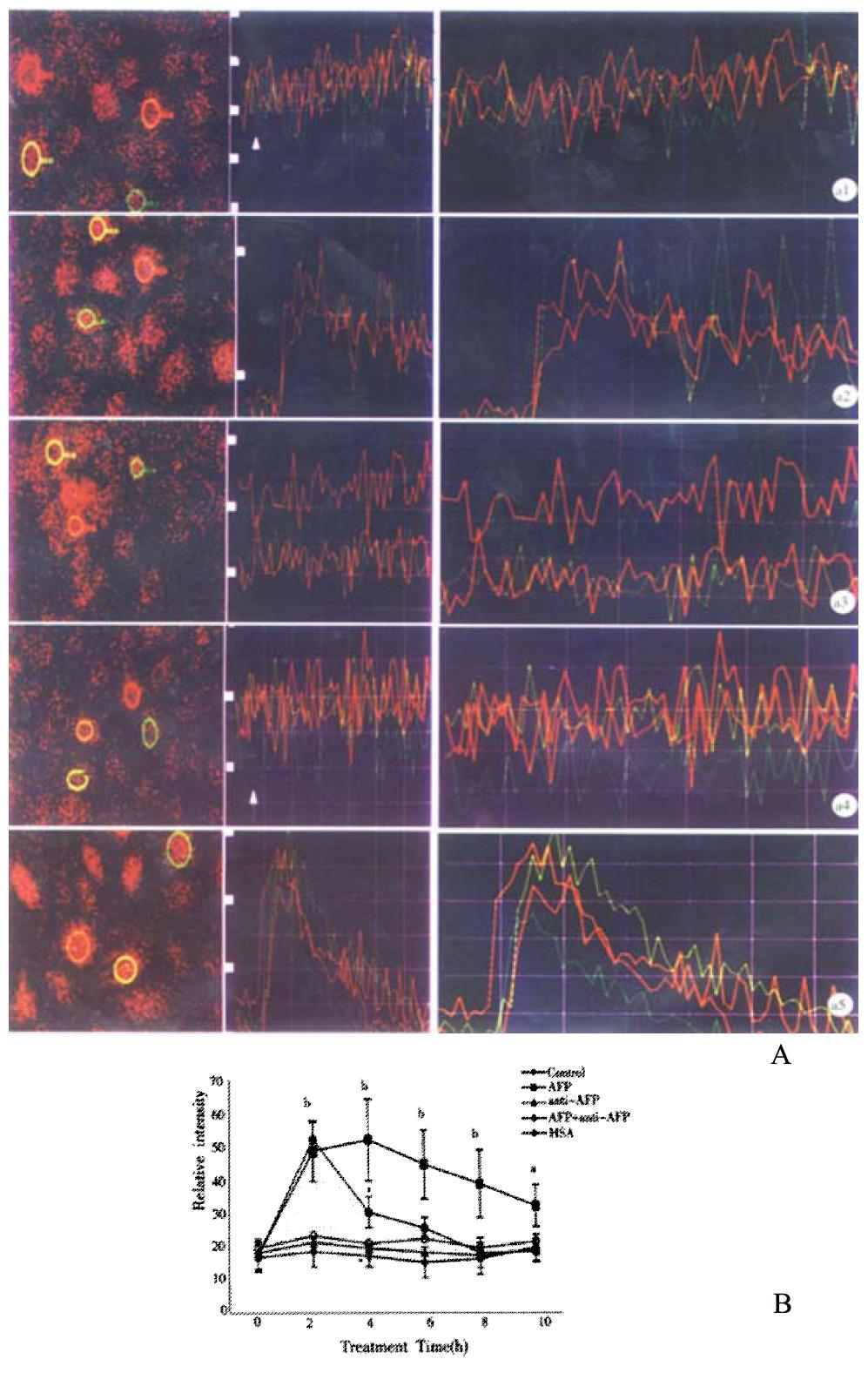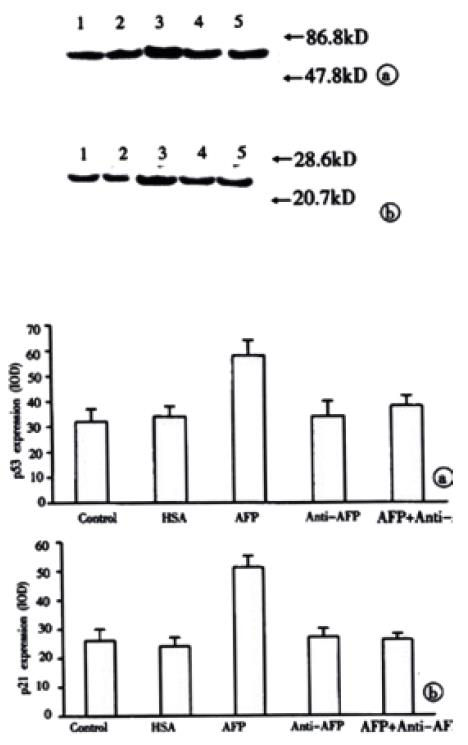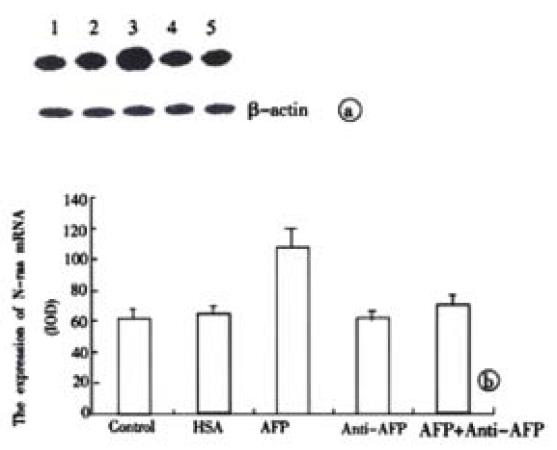Copyright
©The Author(s) 2002.
World J Gastroenterol. Jun 15, 2002; 8(3): 469-475
Published online Jun 15, 2002. doi: 10.3748/wjg.v8.i3.469
Published online Jun 15, 2002. doi: 10.3748/wjg.v8.i3.469
Figure 1 The effects of different concentration of AFP on the proliferation of cells.
Bel 7402 cells were incubated with different concentrations of AFP for 48 h and the cell proliferation was measured by MTT assay. The data represented the mean values of six independent experiments performed each in triplicate. aP < 0.05 and bP < 0.01 vs control (0 mol·L-1).
Figure 2 The blockage of anti-AFP to the effect of AFP on the proliferation of cells.
A. The data of MTT assay. B. The data of 3H-TdR incorporation. The cells were respectively treated with either AFP (20 mg·L-1), anti-AFP (40 mg·L-1), AFP (20 mg·L-1) + anti-AFP (40 mg·L-1) or HSA (20 mg·L-1) for 48 h. (MTT assay) or 18 h (3H-TdR incorporation). The data represented as the mean value of four independent experiments performed each in triplicate. aP < 0.05 and bP < 0.01 vs control (0 mol·L-1).
Figure 3 Scatchard analysis of 125I-AFP binding to Bel 7402 cells.
The properties of AFP receptor in Bel 7402 cells was detected with receptor binding assay and analyzed by a program of Radioligand Binding Assay of Receptor. The data were selected from three independent experiments.
Figure 4 The effects of AFP on the cAMP concentration in cytosol of human hepatoma Bel 7402 cells.
4 × 104 cells were respectively treated with AFP (20 mg·L-1), anti-AFP (40 mg·L-1), AFP (20 mg·L-1) + anti-AFP (40 mg·L-1) or HSA (20 mg·L-1). The data represented the mean values of four independent experiments performed each in triplicate. bP < 0.01 vs control (0 mol·L-1).
Figure 5 The effects of AFP on the activity of PKA in Bel 7402 cells.
4 × 105 cells per ml were respectively treated with either AFP (20 mg·L-1), anti-AFP (40 mg·L-1), AFP (20 mg·L-1) + anti-AFP (40 mg·L-1) or HAS (20 mg·L-1) for differ-ent time and the activities of intracellular PKA were then detected. The data represented the mean values of four independent experiments performed each in triplicate. aP < 0.05 and bP < 0.01 vs control (0 mol·L-1).
Figure 6 A: The change of Ca2+ concentration in human hepatoma Bel7402 cells was measured by confocal microscopic scanning.
Cells were incubated with 5 μmol·L-1 fluo-3/AM at 37 °C for 30 min and then stimulated with Hank’s. (1) AFP (20 mg·L-1); (2) HSA (20 mg·L-1); (3) Anti-AFP; (40 mg·L-1); (4) or AFP (20 mg·L-1) + Anti-AFP (40 mg·L-1); (5) The arrow indicate the stimulated time point. B: The graph shows the scanning results. The data represented as the mean value of 10 cells ± s. aP < 0.05 and bP < 0.01 vs control (0 mol·L-1)
Figure 7 The effects of AFP on the expression of p53 (A) and p21 (B) proteins in Bel 7402 cells.
1 × 105 cells were respectively treated with AFP (20 mg·L-1), anti-AFP (40 mg·L-1), AFP (20 mg·L-1) + anti-AFP (40 mg·L-1) or HSA (20 mg·L-1) for 24 hours and the expression of p53 and p21protein were detected by Western blot assay. Lane 1: control group; lane 2: HSA treated group; lane 3: AFP treated group; lane 4: anti-AFP treated group; lane 5: AFP plus anti-AFP treated group. The data was selected from 3 indepen-dent experiments. A:p53; B:p21. The columns represent the means of triplicate determinations ± s.
Figure 8 The effects of AFP on the expression of N-ras mRNA in Bel 7402 cells.
1 × 105 cells were respectively treated with AFP (20 mg·L-1), anti-AFP (40 mg·L-1), AFP (20 mg·L-1) + anti-AFP (40 mg·L-1) or HSA (20 mg·L-1) for 12 hours and expression of N-ras mRNA was detected by Northern blot assay. Lane 1: control group; Lane 2: HSA treated group; Lane 3: AFP treated group; Lane 4: anti-AFP treated group; Lane 5: AFP plus anti-AFP treated group. The data was selected from 3 independent experiments. A: Auto-radiograph of Northern blot. B: Quantitated by densitometric scanning of N-ras mRNA expression blot in Bel7402 cells (relative IOD units). The columns represent the means of triplicate determinations ± s.
- Citation: Li MS, Li PF, He SP, Du GG, Li G. The promoting molecular mechanism of alpha-fetoprotein on the growth of human hepatoma Bel7402 cell line. World J Gastroenterol 2002; 8(3): 469-475
- URL: https://www.wjgnet.com/1007-9327/full/v8/i3/469.htm
- DOI: https://dx.doi.org/10.3748/wjg.v8.i3.469









